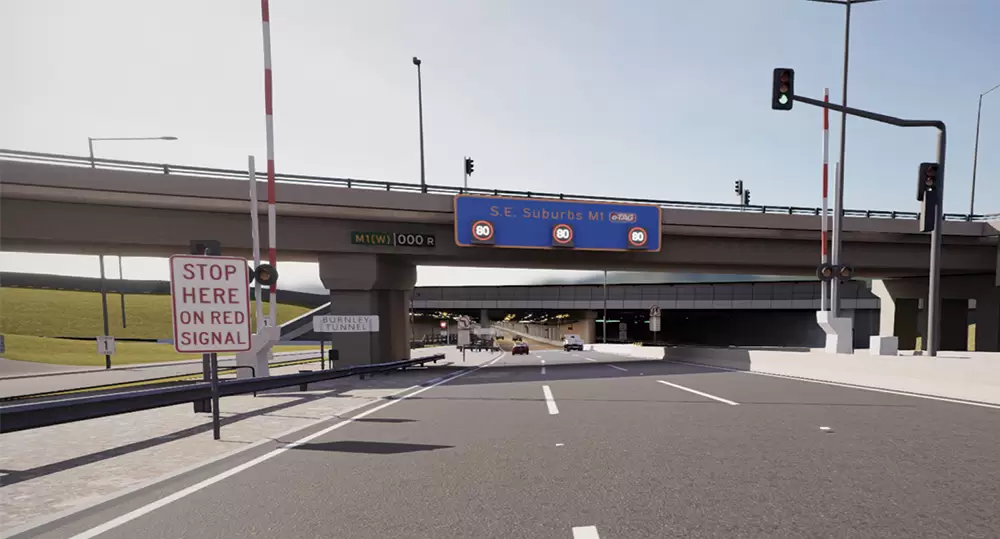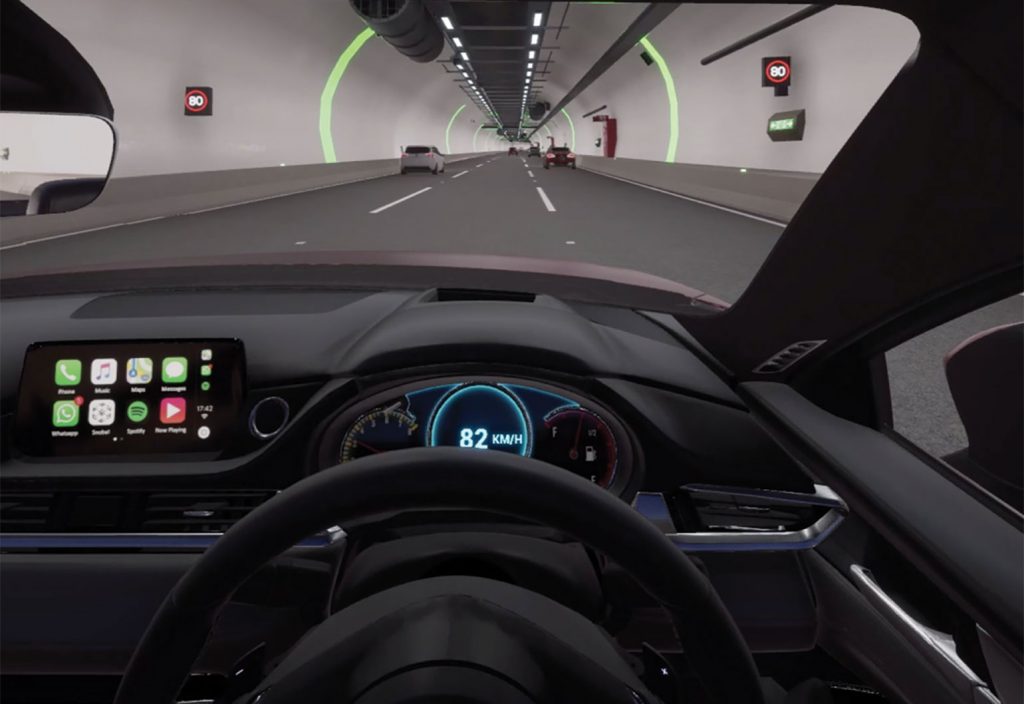Drivers slowing down to pass through a Melbourne tunnel have plagued the thoroughfare with bottlenecks. VR experimentation provided a solution.
What do traffic engineers think about when they’re stuck in traffic? For Chartered engineer David Blair CPEng and his colleagues at engineering firm SMEC, innovative ideas often spring to mind.
During a recent taxi ride through the heart of Melbourne, they came up with a high-tech solution to notorious bottlenecks in the city’s Burnley Tunnel that may change driver behaviour and save tunnel owner Transurban significant costs.

at SMEC.
The 3.4 km Burnley Tunnel carries traffic eastbound via three lanes from the West Gate Freeway to the Monash Freeway and is known for congestion that spans beyond peak hour.
Studies from Transurban show that while drivers enter at the speed limit of 80 km/h, they slow down during the uphill climb out of the tunnel and exit at about 60 km/h, causing traffic to bank up.
There are a number of reasons for the driver behaviour. A tragic accident in the Burnley Tunnel on 3 March 2007 left three people dead and a coroner’s inquest noted the accident had left “a fear in the minds of many using the tunnel as to its safety”.
The Burnley Tunnel is also quite dark and has been known to leak.
“The environment of the tunnel makes it difficult for drivers to perceive the uphill change and how they should respond,” explained Blair, Manager, Transport Planning, Logistics and Analytics at SMEC.
“If Transurban could increase the speed or the vehicle throughput by one per cent, it would be classed as a project success.”
Setting a virtual pace
SMEC’s proposal to Transurban included the delivery of a virtual reality (VR) model of the Burnley Tunnel to examine how potential changes to its physical attributes would impact on driver behaviour.
In the absence of VR, road operators like Transurban would typically look to overseas case studies for best-practice design upgrades.
“Transurban would have potentially looked at tunnels in places like Japan and Scandinavia, where some of the best tunnel design ideas come from, and then implemented those ideas in the Burnley Tunnel,” Blair said.
“The solution would have probably been lighter walls and brighter lights, but the only way to know if it worked would be after completion, when they’d already spent all the money investing in the asset.”
SMEC proposed an innovative methodology to support the redesign of the tunnel, which was accepted by Transurban as part of its overall program of works.
SMEC worked with virtual and augmented reality technology company Snobal to test the proposed designs. Snobal used lidar scans of the Burnley Tunnel to create a digital model in its proprietary platform, Snobal Cloud.

Transurban then recruited 120 drivers, representing a cross-section of road users, who would travel virtually through the tunnel twice — once through a model of the existing tunnel and once through an enhanced version.
Chartered engineer Murray James, Snobal Co-founder, CEO and CTO, says the idea was to help identify the behavioural changes required to solve the bottleneck.
“We can measure how people respond to design changes or changes to any environment in virtual reality,” he said.
“We had a commercial driving simulator hooked up to our software and monitored things like driver eye tracking and heart rate response to stress. We used that information to test various design iterations, such as changes to lighting finishes, traffic lane changes and other elements to induce people to drive in a more proactive manner through the tunnel.
“We basically created a dynamic model of the tunnel where you could tweak the dials and measure how people respond from a vehicle telemetry point of view.”
The tests were conducted in a VR driving rig that looked a little like an arcade machine — a steel frame supporting a driver seat and a steering wheel.
“It looked like an arcade game from the outside, but when you put on the VR headset, you may as well have been in a Mazda 3,” Blair said.
Along with gathering biometric information, testing included a driver survey to gauge what drivers remembered about the experience of driving through both iterations of the VR tunnel.
“The VR driving test numbers gave us the confidence and the certainty that there is a benefit in changing the design, and the qualitative data from the surveys gave us more insight as to what kind of things were going to work and what was preferred,” Blair said.
Pedestrian applications
This is not the first time SMEC has drawn on VR for road projects. Its work on Melbourne’s recent Streamlining Hoddle Street project, for instance, included one of the world’s first road safety audits in virtual reality.
VR has also been used for some time by companies such as Norwegian engineering consultancy Norconsult.
In 2015, for instance, while working on a tunnel project beneath Mount Ulriken, Norway, the company used integrated building information modelling to create a VR game experience for train operators to “drive” through the tunnel before it was built. This helped engineers to optimise signal placement before construction.
James said recent tech developments are making it much easier to digitise environments.
“You can now create a complete digital asset from the existing environment by using drones or aircraft and get really high-definition lidar scans,” he said.
VR can provide validated design testing for complex environments, as well as seemingly simple ones, such as zebra crossings.
Professor Mark Hickman, Chair and Professor of Transport Engineering in the School of Civil Engineering at the University of Queensland, said VR is increasingly being used in pedestrian safety studies.
“I have a PhD student now looking at how people will behave in pedestrian environments like zebra crossings,” he said.
“If you were to introduce autonomous vehicles into that environment, how will people react, especially if they haven’t seen an autonomous vehicle before, or they don’t know whether the vehicle is actually going to stop or slow down, because there’s no driver to interact with.”
Hickman said VR can help engineers understand how pedestrians feel in such situations and test the impact of different design devices.
“If you put in a raised crossing or different colours or striping, does that make the pedestrian feel more confident when an autonomous vehicle approaches? What sort of indication could the vehicle give to let the pedestrian know that it recognises them and it’s safe to cross? VR allows you to test a range of different scenarios.”
Enhanced thoroughfare
The next phase of the Burnley Tunnel project will include a detailed design of the enhanced tunnel, which Blair says may be implemented next year.
“For people to be driving on their roads or their assets, Transurban needs to make a profit,” Blair said. “They cannot indefinitely increase tolls, so they must look to reduce costs. The VR methodology is innovative, but I think the main thrust is that it is a potential major cost-saving initiative that can be applied to any other asset.”
Blair explained that a number of new design elements were considered for the tunnel.
“We looked at paint colours, reflectivity, LED lights, spotlights — all the stuff you’re doing when you’re decorating the house, but this was a tunnel,” he said. “Transurban would ask us to test designs and we’d then go back to them with advice as to what would work.”
Blair added that the new design may include pace-maker lights inside the tunnel to help improve traffic flow.
“As for the new colour in the tunnel, I can’t tell you what it is, but you can probably guess that it will be clean and simple.”
Setting the pace
Pace-maker lighting technology is used in a number of tunnels in countries such as Japan to reduce congestion and regulate traffic flow.
Blair explained that green pace-maker lights were tested in VR models of the Burnley Tunnel. The lights flow at the tunnel speed limit, and drivers subconsciously try to match it.
“It’s a strip of lighting that covers the walls and ceiling and it moves along the tunnel at 80 km/h, or the speed that’s set by the road authority,” he said.
“The lights act as a guide and, without thinking about it, you automatically try to keep up with it and therefore increase your speed to somewhere closer to 80 km/h.”
Blair said studying driver behaviour was an interesting element of the project.
“The human behaviour side of it was something new for us,” he said. “We always believed that if you have a baseline and then you do something different, if you test enough people, the data will tell a story. When we got to the end of the project, we could say ‘this is what we changed, and this is how people responded and this is what happened’.
“I’m certainly not an expert in human behaviour, but it was a very interesting thing to study.”
